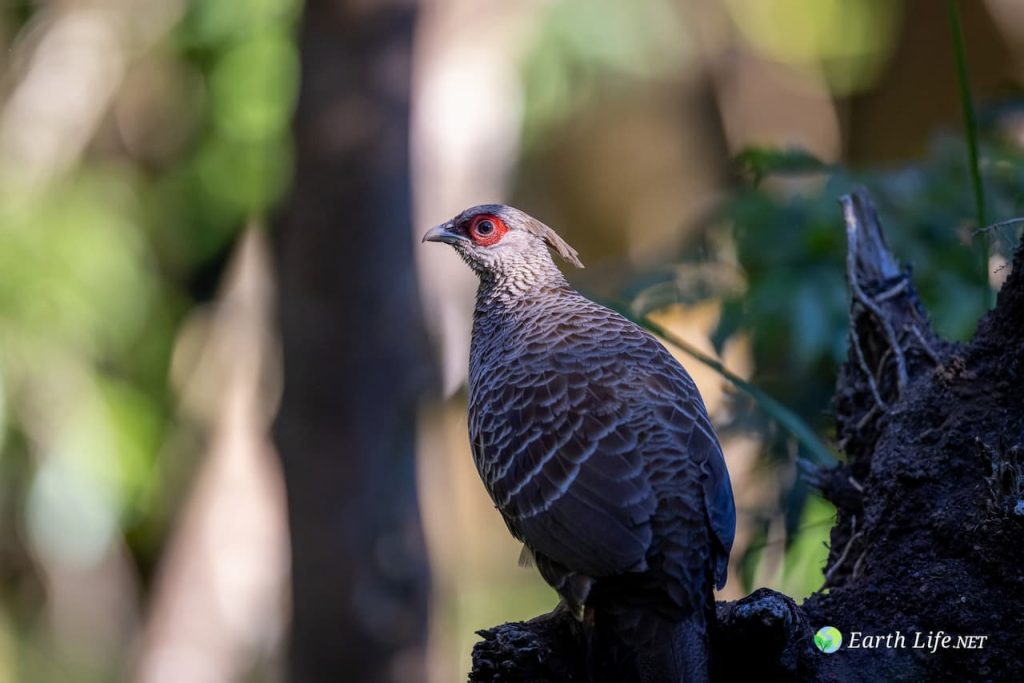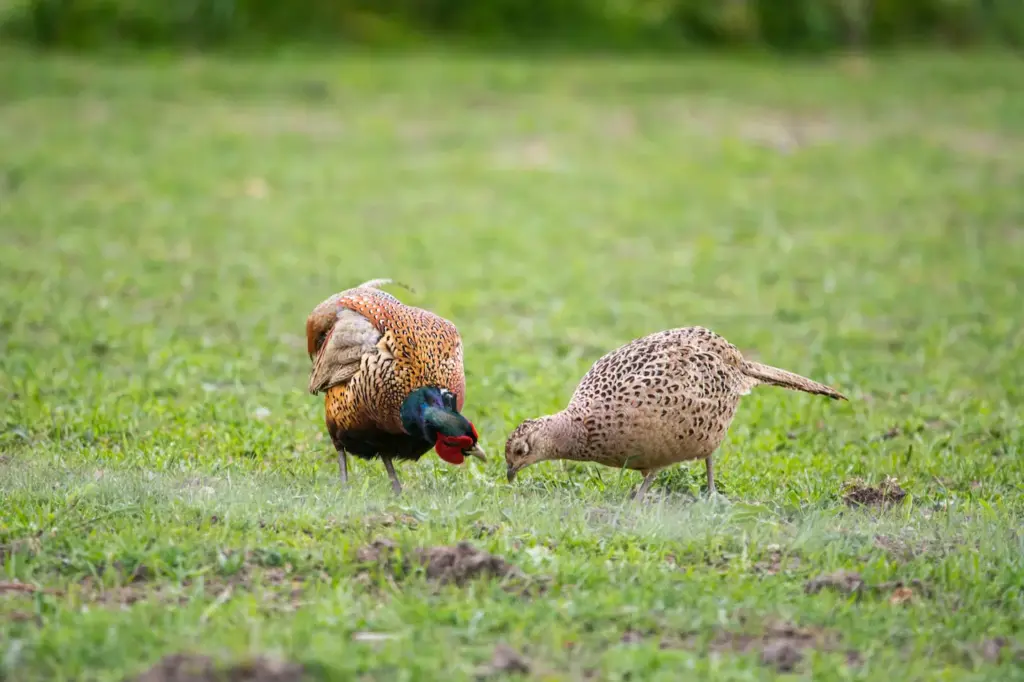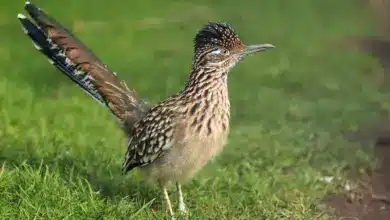Breeding Pheasants
Breeding Pheasants Information
Information on selecting the right pheasants, pairing them, and setting up their cages, as well as care requirements.
Start with healthy birds
Positive signs of Health:
- dry nostrils
- Bright eyes (colors vary with breed)
- Shiny feathers (all Present)
- Good weight and muscle mass for your age
- Clean vent feathers without smell
- Smooth shanks
- straight toes
- Bird Alert and Active
- Pheasant diseases

Basic Breeding Data for Species:
| Species | Origin | Clutch Size | Incubation Days |
| Blood Pheasant | Nepal, Tibet, Myanmar, Northwest China | 5-12 | 27-29 |
| Blue Eared Pheasant | China | 5-8 | 26-28 |
| Blyth’s Tragopan | China | 2-4 | 28 |
| Bronze-tailed Peacock-pheasant | Sumatra | 2 | 22 |
| Brown Eared Pheasant | Western China | 5-8 | 26-27 |
| Bulwer’s Wattled Pheasant | Borneo | 3-8 | 24-26 |
| Cabot’s Tragopan | Southeastern China | 7/8 | 28 |
| Cheer pheasant | Pakistan to Nepal | 9-12 | 26 |
| Congo Peafowl | Congo basin | 3-4 | 26 |
| Copper Pheasant | Japan | 6-12 | 25 |
| Edwards’ Pheasant | Eastern India | 4-7 | 25 |
| Elliot’s Pheasant | Eastern China | 6-8 | 25 |
| Germain’s Peacock-pheasant | Cochin China and southern Annam (India). | 2 | 22 |
| Golden Pheasant | Central China | 6-12 | 22 |
| Green Junglefowl | Java, Bali and Lombok are nearby Indonesian islands. | 6-10 | 21 |
| Green Peafowl | Malay Peninsula, Myanmar, Java | 4-6 | 28 |
| Grey Peacock Pheasant | Sikkim, Myanmar, Thailand, Annam | 2 | 22 |
| Himalayan Monal | Western to eastern Himalayas | 4-8 | 28 |
| Hume’s Pheasant | Northern Myanmar and Northeastern India | 6-11 | 27-28 |
| Imperial Pheasant | India | 5-7 | 25 |
| Indian Peafowl Blue Peafowl | India | 4-8 | 27-29 |
| Kalij Pheasant | Pakistan to Bangladesh | 9-15 | 24-25 |
| Koklass Pheasant | Afghanistan, Pakistan, northern India and Tibet | 9-12 | 26-27 |
| La Fayette’s Junglefowl | Sri Lanka | 2-4 | 20-21 |
| Lady Amherst’s Pheasant | South China | 6-12 | 22 |
| Lesser Bornean Crested Fireback | Java, Borneo | 4-8 | 24 |
| Malay Crested Fireback | Borneo | 3-6 | 22-24 |
| Malay Great Argus | Malay Peninsula | 2 | 24-25 |
| Malay Pheasant | Malay Peninsula | 2 | 22 |
| Mikado Pheasant | Taiwan | 5-10 | 27 |
| Molesworth Tragopan | China | 2/4 | 28 |
| Palawan Pheasant | Philippines | 2 | 18-19 |
| Red Junglefowl | Pakistan to Java | 8-10 | 19-21 |
| Reeve’s Pheasant | Northern China | 7-14 | 25 |
| Rothschild’s Peacock-pheasant | Malay Penisula | 2 | ? |
| Salvadori’s Pheasant | Sumatra | 2 | 22 |
| Satyr Tragopan | (Northern India Sikkim Bhutan | 2-4 | 28 |
| Siamese fireback | Indo-China, Thailand | 5-8 | 24-25 |
| Silver Pheasant | China to Myanmar and Vietnam | 4-6 | 25-26 |
| Sonnerat Junglefowl | Southern India | 4-8 | 20-21 |
| Swinhoe’s Pheasant | Taiwan | 6-12 | 25 |
| Szechuan White-eared Pheasant (Crossoptilon crossoptilon) (Vulnerable/endangered) | China | 4-7 | 24-25 |
| Temminck’s Tragopan | China | 7-8 | 28 |
| Vietnamese pheasant (Lophura hainhensis). | Vietnam | 5-7 | 22 |
| Western Tragopan | Western Himalayas | 3-4 | 28 |
Individual pen mating
- Pros :
Individual pen mating allow the performance of each male, and the performance of the hens mated with that male. The males cannot fight, so there are fewer broken eggs and higher fertility.
- Cons:
In a commercial pheasant-meat operation, individual pen mating can be inefficient and uneconomical. However, they can be used to test certain strains of birds in a breeding program.
Range conditions
- Many pheasants are mated for minimal costs under range conditions. Each bird requires approximately 2m2 for range breeding.
- It is not necessary to choose a green pasture. The chosen site should be dry, well-drained and sheltered.
- Make sure that there is a good covering where the hens can hide from the overly enthusiastic cocks. A good cover will encourage the hens and encourage them to lay their eggs in a central location, rather than scattering them all over your yard.
Special Requirements
Incubation may be necessary to ensure that the eggs hatch successfully. Pheasants do not sit well and are prone to laying their eggs on the ground. To give you some information, it takes approximately 23 days for the ornamental pheasant eggs (including Goldens Amhersts, Nepals Firebacks Silvers Reeves), and 25 days for those of the game birds.
Diet
Pheasants, being omnivores by nature, will eat anything, including fruits and vegetables, seeds and grains, roots and bulbs, leaves, and even grasshoppers. They also eat slugs, snails, and small lizards. They need to have access to live proteins (such as mealworms or maggots), because a lack of protein can increase their tendency to cannibalism. Learn: How to keep animals from eating your bulbs.
You can buy commercial mixed grain rations (make sure they have high protein content) or you can use varieties that include corn with soya beans, meal, and vitamins. Breeders recommend against feeding a layer mash, but a turkey ration can be used. You can add greens, apple diced, and carrot grated to this.
Pheasants, like all birds, need clean water to drink. Keep the water clean, flowing, and fresh.
Hide medication in favorite foods. This is an easy and convenient way to administer medications.
Reproductive problems
- Infectious bronchitis can cause misshaped eggs and weak shells
- Stress can lead to misshaped eggs
- Shell calcium is taken daily from the bones to provide the required amount of calcium in your diet
- Egg Peritonitis is common among good layer breeds such as light purebreds and hybrids
- Infections can delay the onset of laying
- Egg bound: lack available calcium
- Vent gleet
Breeding Pheasants
Author: Randy Sell Research Assistant
Department of Agricultural Economics at NDSU
The Bird Breeders’ Resource: A comprehensive guide to all aspects of breeding birds, including housing, incubation, and raising chicks.
Breeding
Pheasants breed seasonally. When the days get longer, which is usually towards the end of March, the roosters start strutting around and displaying their breeding abilities. Roosters also fight to establish dominance.
It is best to keep a maximum of ten hens for each rooster when raising them in confinement.
Hens begin to lay eggs around the middle of April and will continue until June. If eggs were collected every day and hens were not allowed to start incubating a nest, a single hen would produce about 15 fertile eggs.
Incubators
The pheasant hen is capable of incubating and brooding young pheasants. For commercial production, it is best to buy day-old chicks of pheasant or hatch them in an egg incubator.
In general, allowing the hens in confinement to hatch eggs results in excessive losses in eggs, chicks, and chickens. Incubators also reduce the risk of contagious disease transmission.
The manufacturer of the incubator should be contacted for instructions on how to operate it. Simple machines heat eggs continuously, but other tasks like turning, ventilating, and maintaining humidity are done manually.
These processes are automatically regulated by more expensive and complex incubators.
Daily collection of pheasant egg is required. Incubation must begin before the eggs reach 11 days of age, as fertility decreases with age. Stored eggs should be rotated twice daily to prevent weak chicks from hatching. The temperature of the eggs should not exceed 50 degrees Fahrenheit.
If the eggs have a dull, dirty sheen, it is probably not worth trying them to hatch. It is possible to test the eggs (candle them) if the incubator space is limited.
It is simple to make a test lamp. Simply cut a hole large enough for a pheasant’s egg to fit in. Place the can on top of a small bulb. If the eggs do not have any blood clots, they are infertile.
After 24 1/2 days, ringneck pheasants begin to hatch. The humidity in the incubator must be between 45-50 percent.
Brooding
After all the chicks hatch, keep them in the incubator for as long as it takes to dry completely. More expensive incubators have a nursery area where chicks can dry out completely for 12 to 24 hrs after hatching. The chicks shouldn’t be fed for this period as they are still absorbing the remaining yolk sac. If you feed the chicks food before the yolk sac has been digested, it may cause digestive upsets.
The number of chicks will determine the type of brooder you use.
A 250-watt infrared lamp is suitable for less than 50 chicks. More than 50 chicks in the brooder will require more than one lamp.
For more than 300 chicks, large gas- or electric-operated brooders are used. These have thermostatic controls.
The easiest way to spread pheasant disease is through dirty watering and feeding equipment. It is recommended to clean the feeders and fountains every day with hot water.
Before refilling, the feeders must be completely dry. Place small stones in the fountains to keep the chicks out of the water.
For the first three to four days, a chick guard is placed around the area of brooding. Chick guards are rolled cardboard 24 to 30 inches in height, used to keep birds close to food, water, and the brooder.
After the first day, reduce the temperature in the brooder. Continue to do this until the supplemental heating is no longer required by the end of the fourth week. After the first day, chicks can be taken outside on sunny warm afternoons.
Cannibalism can be reduced by putting weeds and green branches in the pen if the facility does not allow outdoor access on sunny days.
If the weather isn’t unusually cold, you can start placing the birds in outdoor pens known as flyways when they are 5 to 6 weeks old. Flyways that are covered with grasses, weeds, and other vegetation will benefit the birds.
Feeding adults and chicks
After one day, the chicks can be given a game bird starter. It must be a game bird starter as domestic chicken starters do not satisfy young pheasants.
You can scatter the starter pellets on paper plates to get chicks started on food. The chicks are drawn to green paper plates, which may help them eat.
Game bird growers can be fed to chicks after one week. Game bird growers can be a satisfactory feed for the birds until they reach maturity, which is 16 weeks.
To reach maturity, the chicks need up to one pound of starter (a week’s supply) and 10 pounds of the grower (a 15-week supply).
The mature weight of hens is 4,75 pounds and that of roosters is 5.5 pounds. Every four days, grit should be sprinkled over the feed until the chicks have been placed in the flyways.
A pheasant adult will need about 5.5 pounds per month of feed to maintain its condition. The hens need to be fed a high-quality laying ration about three weeks before the start of egg production.
At this stage, hen pheasants can be fed rations that are typically used to feed domestic pheasants. This ration must be fed during the entire laying season.

Buildings, facilities, and equipment
The chicks must be kept in a building for 5 to 6 weeks. Chicks should be housed in buildings that allow for 4 to 5 square feet per chick. For young pheasants, chicken brooder houses and coops are ideal.
In North Dakota, adult pheasants can be kept year-round in flyways. It is recommended that you have access to a shelter to use during winter storms.
Pheasants can survive cold temperatures if they are well-fed and shielded from the wind.
Flyways are the areas where birds spend most of their time. The nets should be between 6 and 7 feet tall, 15 to 20 feet wide with nylon over the top.
For the sidewalls, chicken wire is acceptable with a spacing of 1 inch. To prevent the bottom of the wire from being pushed away and to discourage predators, it should be buried between 6 inches and 1 foot below ground level.
If chicks under 10 days are allowed to fly, the bottom 10 inches should have a solid border, since these chicks will squeeze through 1-inch chicken wire.
Shade should be provided by the flyways. You can provide shade by placing burlap or evergreen branches on top of the nylon roof net. If you use burlap, make sure it is secured to the roof of the flyway so that it doesn’t flap. This could scare the chicks and force them into corners, where they can smother.
There should be enough cover in the flyways to provide birds with “hiding” areas. As long as the birds can be fed and watered, there cannot be too much covering in the flyways.
These hiding places serve a variety of purposes. Cannibalism will decrease if the birds can hide from each other or find a safe place to escape. The birds will also be less frightened and the injuries will be decreased.
If the pheasants will be kept to breed, adding straw bales can provide nesting areas where eggs can collected.
incubator is only required if you want to maintain a flock of breeding pheasants. Brooders, water fountains, and fencing materials are all other equipment that is needed to keep pheasants.
Predators
Rats can be a nuisance in areas where pheasants breed, under floors, and in walls. Rats will not attack mature birds but will eat young chicks or eggs.
Rats can attract other predators, such as weasels, minks, and foxes, in addition to carrying disease.
The best way to control rats is by cleaning up the trash and other rubbish. Do not allow them access to feed storage areas for pheasants. Commercial poisons are available to control rat populations.
The problem with larger predatory mammal species is that they are only dangerous if you can allow them to access the flyways. Leg-hold traps can be used to control raccoons or minks.
Owls are a potential problem in domestic pheasant farming. Owls can be a problem for domestic pheasant production.
Most predatory losses are preventable with well-constructed flyways, and by cleaning up waste feeds and trash.






